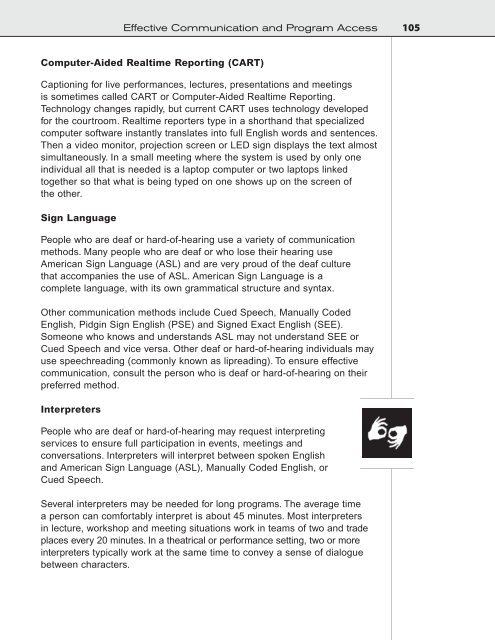Design for Accessibility: A Cultural Administrator's Handbook
Design for Accessibility: A Cultural Administrator's Handbook
Design for Accessibility: A Cultural Administrator's Handbook
You also want an ePaper? Increase the reach of your titles
YUMPU automatically turns print PDFs into web optimized ePapers that Google loves.
Effective Communication and Program Access 105<br />
Computer-Aided Realtime Reporting (CART)<br />
Captioning <strong>for</strong> live per<strong>for</strong>mances, lectures, presentations and meetings<br />
is sometimes called CART or Computer-Aided Realtime Reporting.<br />
Technology changes rapidly, but current CART uses technology developed<br />
<strong>for</strong> the courtroom. Realtime reporters type in a shorthand that specialized<br />
computer software instantly translates into full English words and sentences.<br />
Then a video monitor, projection screen or LED sign displays the text almost<br />
simultaneously. In a small meeting where the system is used by only one<br />
individual all that is needed is a laptop computer or two laptops linked<br />
together so that what is being typed on one shows up on the screen of<br />
the other.<br />
Sign Language<br />
People who are deaf or hard-of-hearing use a variety of communication<br />
methods. Many people who are deaf or who lose their hearing use<br />
American Sign Language (ASL) and are very proud of the deaf culture<br />
that accompanies the use of ASL. American Sign Language is a<br />
complete language, with its own grammatical structure and syntax.<br />
Other communication methods include Cued Speech, Manually Coded<br />
English, Pidgin Sign English (PSE) and Signed Exact English (SEE).<br />
Someone who knows and understands ASL may not understand SEE or<br />
Cued Speech and vice versa. Other deaf or hard-of-hearing individuals may<br />
use speechreading (commonly known as lipreading). To ensure effective<br />
communication, consult the person who is deaf or hard-of-hearing on their<br />
preferred method.<br />
Interpreters<br />
People who are deaf or hard-of-hearing may request interpreting<br />
services to ensure full participation in events, meetings and<br />
conversations. Interpreters will interpret between spoken English<br />
and American Sign Language (ASL), Manually Coded English, or<br />
Cued Speech.<br />
Several interpreters may be needed <strong>for</strong> long programs. The average time<br />
a person can com<strong>for</strong>tably interpret is about 45 minutes. Most interpreters<br />
in lecture, workshop and meeting situations work in teams of two and trade<br />
places every 20 minutes. In a theatrical or per<strong>for</strong>mance setting, two or more<br />
interpreters typically work at the same time to convey a sense of dialogue<br />
between characters.


